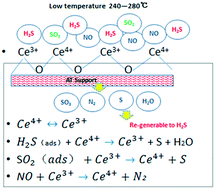当前位置:
X-MOL 学术
›
React. Chem. Eng.
›
论文详情
Our official English website, www.x-mol.net, welcomes your
feedback! (Note: you will need to create a separate account there.)
Simultaneous catalytic reduction of SO2 and NO from flue gas using H2S as a reductant at low temperatures
Reaction Chemistry & Engineering ( IF 3.4 ) Pub Date : 2020/01/15 , DOI: 10.1039/c9re00347a Xianghong Lü 1, 2, 3, 4, 5 , Hao Li 1, 2, 3, 4, 5 , Xiaohui Du 1, 2, 3, 4, 5 , Xue Wang 1, 2, 3, 4, 5 , Minyi Lan 1, 2, 3, 4, 5 , Jianlin Wu 1, 2, 3, 4, 5 , Jin Zhu 1, 2, 3, 4, 5 , Jianliang Sun 1, 2, 3, 4, 5 , Feng Jiang 4, 5, 6, 7
Reaction Chemistry & Engineering ( IF 3.4 ) Pub Date : 2020/01/15 , DOI: 10.1039/c9re00347a Xianghong Lü 1, 2, 3, 4, 5 , Hao Li 1, 2, 3, 4, 5 , Xiaohui Du 1, 2, 3, 4, 5 , Xue Wang 1, 2, 3, 4, 5 , Minyi Lan 1, 2, 3, 4, 5 , Jianlin Wu 1, 2, 3, 4, 5 , Jin Zhu 1, 2, 3, 4, 5 , Jianliang Sun 1, 2, 3, 4, 5 , Feng Jiang 4, 5, 6, 7
Affiliation

|
Although harmful NO and SO2 in flue gas can be separately removed by established technologies, such as selective catalytic reduction (SCR) or selective non-catalytic reduction (SNCR) and a wet scrubbing process, an integrated method for simultaneous desulfurization and denitrification is still in demand and attractive to improve energy efficiency and reduce investment and operation costs. Upon this, a novel sulfur-cycling integrated technology (simultaneous catalytic desulfurization and denitrification with H2S (H2S-SCDD)) has been proposed and is considered to be a profitable solution for the flue gas treatment. However, a high operation temperature (over 600 °C) is required in the H2S-SCDD process for the sulfur-cycling flue gas treatment as reported. To realize the H2S-SCDD process at low temperatures, different catalysts were prepared and tested, such as Al2O3–TiO2 (AT) loaded with transition metal oxides. The results show that a CeO2-loaded AT catalyst (Ce–AT) was the suitable catalyst to balance NO and SO2 removal by the H2S-SCDD process in the temperature range of 300–400 °C. Increasing Ce loading on AT significantly increased the NO conversion but had a slightly negative effect on SO2 reduction. With 15% Ce loading on the AT catalyst (Ce15–AT), the optimal temperature for the H2S-SCDD process was 240–280 °C. While at 280 °C, the SO2 and NO conversions were about 75% and 90%, respectively, implying the efficient and simultaneous reduction of NO and SO2. Upon this, the sulfur-cycling process is promising and attractive for flue gas treatment in industrial sectors.
中文翻译:

在低温下使用H2S作为还原剂同时催化烟气中SO2和NO的还原
尽管可以通过诸如选择性催化还原(SCR)或选择性非催化还原(SNCR)和湿式洗涤工艺之类的既定技术分别除去烟气中有害的NO和SO 2,但仍需要同时进行脱硫和反硝化的综合方法需求旺盛并具有吸引力,以提高能源效率并降低投资和运营成本。在此基础上,提出了一种新型的硫循环集成技术(同时进行H 2 S催化脱硫和反硝化(H 2 S-SCDD)),被认为是烟气处理的有利解决方案。但是,H 2需要较高的工作温度(超过600°C)据报道,S-SCDD工艺用于硫循环烟气的处理。为了在低温下实现H 2 S-SCDD工艺,制备并测试了不同的催化剂,例如负载过渡金属氧化物的Al 2 O 3 -TiO 2(AT)。结果表明,在300–400°C的温度范围内,负载CeO 2的AT催化剂(Ce–AT)是平衡H 2 S-SCDD工艺去除NO和SO 2的合适催化剂。铈对AT的负载增加显着增加了NO的转化率,但对SO 2的还原略有负面影响。在AT催化剂(Ce15–AT)上负载15%的铈时,H 2的最佳温度S-SCDD过程为240–280°C。在280°C时,SO 2和NO的转化率分别约为75%和90%,这意味着可以同时有效地还原NO和SO 2。基于此,硫循环工艺对于工业领域的烟道气处理是有前途的且有吸引力的。
更新日期:2020-03-03
中文翻译:

在低温下使用H2S作为还原剂同时催化烟气中SO2和NO的还原
尽管可以通过诸如选择性催化还原(SCR)或选择性非催化还原(SNCR)和湿式洗涤工艺之类的既定技术分别除去烟气中有害的NO和SO 2,但仍需要同时进行脱硫和反硝化的综合方法需求旺盛并具有吸引力,以提高能源效率并降低投资和运营成本。在此基础上,提出了一种新型的硫循环集成技术(同时进行H 2 S催化脱硫和反硝化(H 2 S-SCDD)),被认为是烟气处理的有利解决方案。但是,H 2需要较高的工作温度(超过600°C)据报道,S-SCDD工艺用于硫循环烟气的处理。为了在低温下实现H 2 S-SCDD工艺,制备并测试了不同的催化剂,例如负载过渡金属氧化物的Al 2 O 3 -TiO 2(AT)。结果表明,在300–400°C的温度范围内,负载CeO 2的AT催化剂(Ce–AT)是平衡H 2 S-SCDD工艺去除NO和SO 2的合适催化剂。铈对AT的负载增加显着增加了NO的转化率,但对SO 2的还原略有负面影响。在AT催化剂(Ce15–AT)上负载15%的铈时,H 2的最佳温度S-SCDD过程为240–280°C。在280°C时,SO 2和NO的转化率分别约为75%和90%,这意味着可以同时有效地还原NO和SO 2。基于此,硫循环工艺对于工业领域的烟道气处理是有前途的且有吸引力的。









































 京公网安备 11010802027423号
京公网安备 11010802027423号